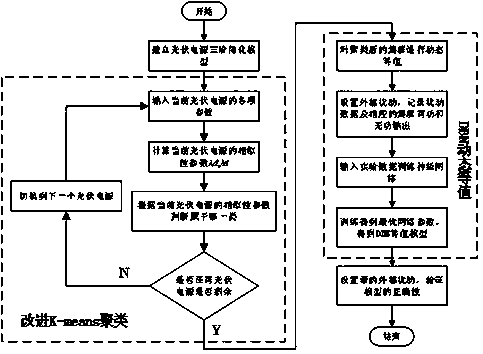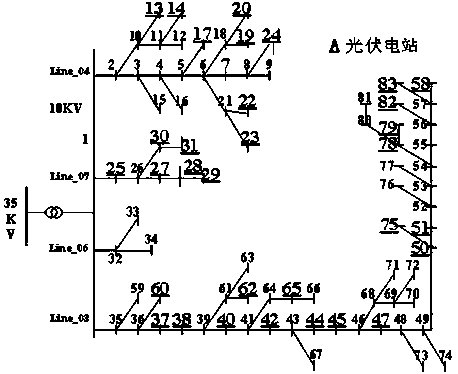Dynamic equivalent modeling method of distributed photovoltaic cluster based on deep belief network
A deep belief network and distributed photovoltaic technology, applied in the field of value modeling, can solve the problems of tediousness and complexity in the conversion process, achieve the effect of reducing the amount of calculation and theoretical derivation, universal modeling methods, and avoiding errors
- Summary
- Abstract
- Description
- Claims
- Application Information
AI Technical Summary
Problems solved by technology
Method used
Image
Examples
Embodiment 1
[0048] Dynamic equivalent modeling method of distributed photovoltaic cluster based on deep belief network, such as figure 1 As shown, including the following steps:
[0049] S1, establishing a third-order simplified model of the photovoltaic power generation unit, the simplified model including a photovoltaic array model, a combined simplified model of photovoltaic cells and chopper circuit, an inverter average control model, and an inverter controller model;
[0050] The photovoltaic array model is:
[0051]
[0052] The combined simplified model of photovoltaic cell and chopper circuit is:
[0053]
[0054] Inverter average control model:
[0055] U AC =[K d sin(ωt+θ)+K q sin(ωt+θ-π / 2)]U dc
[0056] Inverter controller model:
[0057]
[0058] Among them, S is the light intensity (W·m- 2 ), T(K) is the ambient temperature, U pv ,I pv Are the output DC voltage and current of the photovoltaic array, P pvmax Is the maximum power of photovoltaic modules, C dc Is the chopper outlet ca...
Embodiment 2
[0082] An example is listed below to help illustrate the feasibility and technical advantages of the dynamic equivalent modeling method disclosed in the present invention.
[0083] Take an actual distribution network system with distributed photovoltaic power stations in Anhui Province as an example. The system has 83 nodes and 32 photovoltaic power stations. The photovoltaic access points are such as image 3 Shown: The photovoltaic power generation units all adopt the third-order simplified model. After cluster clustering, 6 small-scale photovoltaic clusters are finally obtained. Each photovoltaic power generation unit in the cluster has similar dynamic characteristics. The results of cluster division are shown in Table 1:
[0084] Table 1 Cluster division results
[0085] Photovoltaic cluster
The location of the node where the photovoltaic power source is connected in the cluster
Cluster 1
7,13,17,19,20,22,23,24
Cluster 2
25,27,28,29,30,31
Cluster 3
37,38,40,60,62
Cluste...
PUM
 Login to View More
Login to View More Abstract
Description
Claims
Application Information
 Login to View More
Login to View More - R&D
- Intellectual Property
- Life Sciences
- Materials
- Tech Scout
- Unparalleled Data Quality
- Higher Quality Content
- 60% Fewer Hallucinations
Browse by: Latest US Patents, China's latest patents, Technical Efficacy Thesaurus, Application Domain, Technology Topic, Popular Technical Reports.
© 2025 PatSnap. All rights reserved.Legal|Privacy policy|Modern Slavery Act Transparency Statement|Sitemap|About US| Contact US: help@patsnap.com



